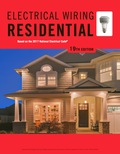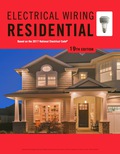
EBK ELECTRICAL WIRING RESIDENTIAL
19th Edition
ISBN: 9781337516549
Author: Simmons
Publisher: CENGAGE LEARNING - CONSIGNMENT
expand_more
expand_more
format_list_bulleted
Concept explainers
Question
Chapter 27, Problem 45R
To determine
Mention the section of the NEC Code that prohibits the use of sheet metal screws to attach the grounding conductor.
Expert Solution & Answer
Want to see the full answer?
Check out a sample textbook solution
Students have asked these similar questions
Find the Thevenin Equivalent of the circuit below, show all steps;
Find the Thevenin Equivalent Circuit of the following and find the current through R_L, show all steps;
Find the Thevenin Equivalent Circuit of the circuit below and the current through R_L , show all steps;
Chapter 27 Solutions
EBK ELECTRICAL WIRING RESIDENTIAL
Ch. 27 - Define the Service Point. ______________Ch. 27 - Define service-drop conductors.Ch. 27 - Prob. 3RCh. 27 - a. The service head must be located (above)...Ch. 27 - Prob. 5RCh. 27 - When a conduit is extended through a roof, must it...Ch. 27 - a. What size and type of conductors are installed...Ch. 27 - How and where is the grounding electrode conductor...Ch. 27 - What are the minimum distances or clearances for...Ch. 27 - What are the minimum size ungrounded conductors...
Ch. 27 - What is the minimum size copper grounding...Ch. 27 - What is the recommended height of a meter socket...Ch. 27 - Prob. 13RCh. 27 - Prob. 14RCh. 27 - Prob. 15RCh. 27 - Prob. 16RCh. 27 - Prob. 17RCh. 27 - Prob. 18RCh. 27 - Prob. 19RCh. 27 - Prob. 20RCh. 27 - Prob. 21RCh. 27 - Prob. 22RCh. 27 - Prob. 23RCh. 27 - Prob. 24RCh. 27 - Prob. 25RCh. 27 - Prob. 26RCh. 27 - Prob. 27RCh. 27 - Prob. 28RCh. 27 - Prob. 29RCh. 27 - Prob. 30RCh. 27 - Prob. 31RCh. 27 - Prob. 32RCh. 27 - Prob. 33RCh. 27 - Prob. 34RCh. 27 - Prob. 35RCh. 27 - Prob. 36RCh. 27 - Prob. 37RCh. 27 - Prob. 38RCh. 27 - Prob. 39RCh. 27 - Prob. 40RCh. 27 - Prob. 42RCh. 27 - Prob. 43RCh. 27 - Prob. 44RCh. 27 - Prob. 45RCh. 27 - Prob. 46RCh. 27 - Prob. 47RCh. 27 - Prob. 48R
Knowledge Booster
Learn more about
Need a deep-dive on the concept behind this application? Look no further. Learn more about this topic, electrical-engineering and related others by exploring similar questions and additional content below.Similar questions
- Find the Norton Equivalent of the below and the voltage across R_L, show all steps;arrow_forwardUse Mesh Analysis to find the current through the laod resistor R_L. Show all steps;arrow_forwardFind Thevenin Equivalent of the circuit below and the current through the load resistor R_L. Show all steps;arrow_forward
- If = 5000 A actual time IDMT ---R,, Reand R3 The Tsm relays R, and R3 Draw The characteistic relays time margin between Tsm = 0.5 RCT=500/1 CS-125% TSM = 2 TSM = 0.2 and -0.6 R2 CTS = 500/1 Cs=100% Tsm=0.4 R3 CTS = 400/1 Cs=125% TSM = 2arrow_forwardLet X and Y be random variables having joint density function 01.5). (c) p(x) and p(y).arrow_forwardThe joint density function of two continuous random variables X and Y is: p(x, y) = {cxy 0 < x < 4,1 < y < 5 0 otherwise Find (i) the constant c (ii)P(1arrow_forwardBelow is a rough schematic of the lighting system for a streetcar powered by a 120 VDC supply. How can I arrange the wires inside the trolley for the interior lights (1-16), headlights (19-20), doors (21-24), and platform lights (17-18), ensuring that each has its own switch? Does the electrical system require additional safety components? What type of cable can be used for wiring these lights?arrow_forward12.8 Obtain the inverse Laplace transform of each of the fol- lowing functions by first applying the partial-fraction-expansion method. (a) Fi(s) 6 = (s+2)(s+4) (b) F2(s) = (c) F3(s) = 4 (s+1)(s+2)2 3s3 +36s2+131s+144 s(s+4)(s²+6s+9) 2s²+4s-10 (d) F4(s) = (s+6)(s+2)²arrow_forward12.4 Determine the Laplace transform of each of the followingfunctions by applying the properties given in the Tables (a) f1(t) = 4te−2t u(t)(b) f2(t) = 10cos(12t +60◦) u(t)*(c) f3(t) = 12e−3(t−4) u(t −4)(d) f4(t) = 30(e−3t +e3t ) u(t)(e) f5(t) = 16e−2t cos4t u(t)(f) f6(t) = 20te−2t sin4t u(t)arrow_forward8. Obtain the inverse Laplace transform of each of the followingfunctions by first applying the partial-fraction-expansionmethod.(a) F1(s) =6(s+2)(s+4)(b) F2(s) =4(s+1)(s+2)2(c) F3(s) =3s3 +36s2 +131s+144s(s+4)(s2 +6s+9)(d) F4(s) =2s2 +4s−10(s+6)(s+2)2arrow_forward12.12 In the circuit of Fig. P12.12(a), is(t) is given by the waveform shown in Fig. P12.12(b). Determine iL (t) for t≥ 0, given that R₁ = R₂ = 2 2 and L = 4 H. is() R₁ R2: (a) Circuit is(t) 8A- 8e-21 elle (b) is(t) Figure P12.12 Circuit and waveform for Problem 12.12. iLarrow_forward12.12 In the circuit of Fig. P12.12(a), is(t) is given by thewaveform shown in Fig. P12.12(b). Determine iL(t) for t ≥ 0,given that R1 = R2 = 2 W and L = 4 H.arrow_forwardarrow_back_iosSEE MORE QUESTIONSarrow_forward_ios
Recommended textbooks for you
 EBK ELECTRICAL WIRING RESIDENTIALElectrical EngineeringISBN:9781337516549Author:SimmonsPublisher:CENGAGE LEARNING - CONSIGNMENT
EBK ELECTRICAL WIRING RESIDENTIALElectrical EngineeringISBN:9781337516549Author:SimmonsPublisher:CENGAGE LEARNING - CONSIGNMENT

EBK ELECTRICAL WIRING RESIDENTIAL
Electrical Engineering
ISBN:9781337516549
Author:Simmons
Publisher:CENGAGE LEARNING - CONSIGNMENT
Types of House Wiring - Types of Electrical Wiring - Electrical Wiring; Author: Learning Engineering;https://www.youtube.com/watch?v=A5P-buWX-dA;License: Standard Youtube License